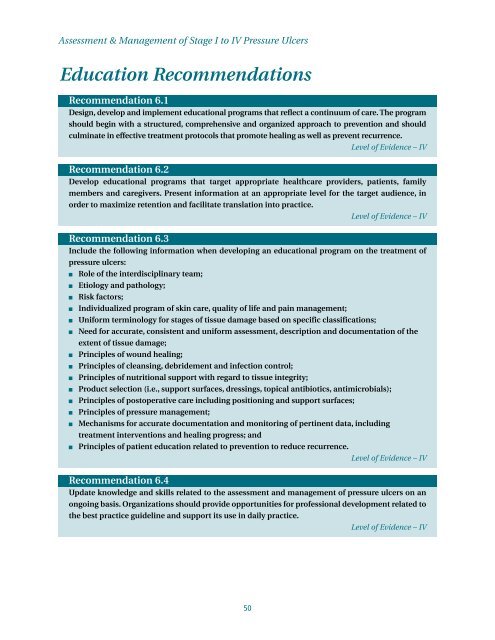RNAO BPG Pressure Ulcers Stage I to IV - Faculty of Health ...
RNAO BPG Pressure Ulcers Stage I to IV - Faculty of Health ...
RNAO BPG Pressure Ulcers Stage I to IV - Faculty of Health ...
You also want an ePaper? Increase the reach of your titles
YUMPU automatically turns print PDFs into web optimized ePapers that Google loves.
Assessment & Management <strong>of</strong> <strong>Stage</strong> I <strong>to</strong> <strong>IV</strong> <strong>Pressure</strong> <strong>Ulcers</strong>Education RecommendationsRecommendation 6.1Design, develop and implement educational programs that reflect a continuum <strong>of</strong> care. The programshould begin with a structured, comprehensive and organized approach <strong>to</strong> prevention and shouldculminate in effective treatment pro<strong>to</strong>cols that promote healing as well as prevent recurrence.Level <strong>of</strong> Evidence – <strong>IV</strong>Recommendation 6.2Develop educational programs that target appropriate healthcare providers, patients, familymembers and caregivers. Present information at an appropriate level for the target audience, inorder <strong>to</strong> maximize retention and facilitate translation in<strong>to</strong> practice.Level <strong>of</strong> Evidence – <strong>IV</strong>Recommendation 6.3Include the following information when developing an educational program on the treatment <strong>of</strong>pressure ulcers:■ Role <strong>of</strong> the interdisciplinary team;■ Etiology and pathology;■ Risk fac<strong>to</strong>rs;■ Individualized program <strong>of</strong> skin care, quality <strong>of</strong> life and pain management;■ Uniform terminology for stages <strong>of</strong> tissue damage based on specific classifications;■ Need for accurate, consistent and uniform assessment, description and documentation <strong>of</strong> theextent <strong>of</strong> tissue damage;■ Principles <strong>of</strong> wound healing;■ Principles <strong>of</strong> cleansing, debridement and infection control;■ Principles <strong>of</strong> nutritional support with regard <strong>to</strong> tissue integrity;■ Product selection (i.e., support surfaces, dressings, <strong>to</strong>pical antibiotics, antimicrobials);■ Principles <strong>of</strong> pos<strong>to</strong>perative care including positioning and support surfaces;■ Principles <strong>of</strong> pressure management;■ Mechanisms for accurate documentation and moni<strong>to</strong>ring <strong>of</strong> pertinent data, includingtreatment interventions and healing progress; and■ Principles <strong>of</strong> patient education related <strong>to</strong> prevention <strong>to</strong> reduce recurrence.Level <strong>of</strong> Evidence – <strong>IV</strong>Recommendation 6.4Update knowledge and skills related <strong>to</strong> the assessment and management <strong>of</strong> pressure ulcers on anongoing basis. Organizations should provide opportunities for pr<strong>of</strong>essional development related <strong>to</strong>the best practice guideline and support its use in daily practice.Level <strong>of</strong> Evidence – <strong>IV</strong>50
















